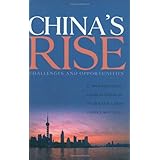
Average Reviews:

(More customer reviews)Are you looking to buy China's Rise: Challenges and Opportunities? Here is the right place to find the great deals. we can offer discounts of up to 90% on China's Rise: Challenges and Opportunities. Check out the link below:
>> Click Here to See Compare Prices and Get the Best Offers
China's Rise: Challenges and Opportunities ReviewBergsten's book provides good insights into today's China. China has become a global economic power - second largest national economy, second largest exporter, largest foreign exchange reserves. Its real GDP in 2006 was about 13X that of 1978 when reforms began.President Jiang Zemin's 2002 "Three Represents" (represent the majority and major components) allowed the formerly reviled entrepreneurs to join the CCP, co opting its rising middle class and intellectuals. The National People's Congress no longer rubber-stamps everything put before it by the State council - evidence includes protracted drafting of the Property Law, and 10% voting against Zemin staying as chair of the Central Military Committee. Recently there were 8% more candidates than slots, and the Minister of Health was not a CCP member.
The central government collects taxes nationwide, splitting the receipts about evenly with local governments. 'Growth at any cost' rules at the local level, creating environment problems; also the local governments don't get enough funding to cover all the central mandates. Local governments are responsible for appointing local officials and judges, along with their pay. Thus, local adherence to central mandates is sometimes half-hearted and frustrates U.S. personnel.
The spring of 1989 brought people into the streets in support student-led demonstrations - inflation and official profiteering were major concerns. Chinese corruption appears to have leveled out in the last 15 -years - now approximately at the same level as India, Mexico, Brazil, and better than the U.S.S.R. The most vulnerable areas involve real estate - state funds for real-estate loans, land seizures without proper payment. Bergsten believes this costs about 3-4%/year of GDP.
China's current aim is growth through increased domestic consumption. Benefits include reduced protectionist backlash, faster employment growth than more heavy industry (and faster income equalization), less capital intensive, and less harmful to the environment. Industry takes about 2/3 of China's energy; China has more heavy industry than Japan and India, and therefore greater pollution. Energy prices are controlled by the Chinese government.
It is now commonly recognized that no major international challenge can be met without China's assistance.China's Rise: Challenges and Opportunities Overview
Want to learn more information about China's Rise: Challenges and Opportunities?
>> Click Here to See All Customer Reviews & Ratings Now
0 comments:
Post a Comment